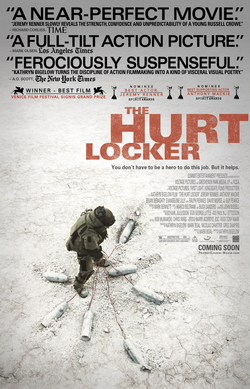

For my formal film study I looked at the war film genre by viewing three films, Platoon, The Hurt Locker, and We Were Soldiers. One of the biggest themes that I found between these three films was the theme of a brotherhood. In The Hurt Locker, the squad sent to diffuse bombs is a very tight knight group that depend on each other. One of the main scenes that illustrates this is after a mission, they return to base. The film depicts the three soldiers in the squad wrestling around, drinking, and just having a good time. It offers a break from the war scenes and gun fire that are present in majority of the movie. It also represents a turning point where all the soldiers truly come together as one unit.
We Were Soldiers stresses throughout the movie the importance of the soldiers coming together. In the scene before they head off to war, the lieutenant colonel gives a speech. In it, he emphasizes that the soldiers must forget about race, religion, and other things because "in war, your brothers-in-arms are all you got." It is also evident in the end. After the Lt. Colonel orders his troops to attack a large amount of NVA troops and they break through the NVA lines, the Colonel wonders whether he has done the right thing. He states "I will never forgive myself." because of the amount of troops that were killed because of his orders.
Platoon takes a more mixed stance on brotherhood in war. Platoon shows that there is brotherhood as emphasized by the scene when Taylor is finally accepted as a member of the platoon and is invited to join them in their cabin. However, the film also shows a selfishness and corruption of this brotherhood when Barnes shoots and kills Sgt. Elias. He kills him in order to avoid being charged with unlawful murders, which is a completely selfish act. This is in contrast to the earlier movies were all soldiers are seen doing selfless acts in order to save their fellow soldiers.
I thought We Were Soldiers also does a good job in offering a social critique of the Vietnam era society. In one scene, it shows a book club with many of the wives of the soldiers. When one of the wives, who is from northern states, comments "they have laundry mats around here but they don't let you wash colors. They have big signs that say 'Whites only'". It almost offers a humorous look at racial segregation because of her cluelessness to it. It also shows the contrast in civilian life, where blacks and whites were separated, and life during war time, were the color of your skin did not matter. I think another scene that depicts negatives of the Vietnam war are when the families are informed of the deaths of their loved ones. A telegram is dispatched, and they are simply given a piece of paper that informs them of the death. It seems so impersonal and I think it is emphasized even better because the director chose to switch between shots of the families getting the letters and the piles of dead American soldiers.
Hurt Locker and We Were Soldiers offer a much cleaner, more pure form of war than Platoon. In Platoon, the soldiers not only have to look out for Vietnamese soldiers, but also must fear of fragging and friendly fire. I think Hurt Locker portrays a much cleaner, less personal form of war. You never really see who is doing the killing or who the enemy is but rather the bombs that they leave behind. We Were Soldiers does an interesting thing where they show scenes of the NVA and their commander talking to his troops. This parallels other scenes of the American commander and helps to add a more human side to the NVA troops. I feel many time in war films we separate the good and bad and it in a way makes us happy when the "bad" guys are shot and killed. This showing of the NVA troops and their portrayal as more human gives more meaning to their deaths and the massive tool that war truly takes on people.
The films all used sound as a advantage but one of the most important aspects that added to the feel was the confusion that was created by the camera. All three films had hectic battle scenes where you did not know where the firing was coming from, with fast cuts and people running everywhere, you feel lost in the battle. Hurt Locker did not do this as much as the other films but mainly because this film there was not many person on person gun fights.
In Hurt Locker, I feel that the large lack of person on person conflict offers a small critique on modern warfare. The soldiers lack any sympathy for the people that they kill and many times they do not even see their faces. In the scene where they are pinned down by a sniper, the unit grabs a 50 caliber sniper and attempts to kill the enemies. They are attacking from a distance where the enemy is barley visible to the naked eye.